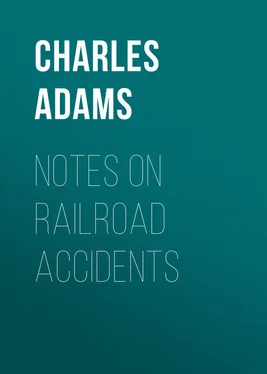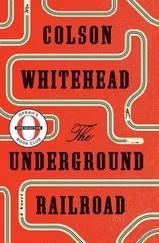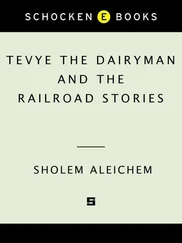Charles Adams - Notes on Railroad Accidents
Здесь есть возможность читать онлайн «Charles Adams - Notes on Railroad Accidents» — ознакомительный отрывок электронной книги совершенно бесплатно, а после прочтения отрывка купить полную версию. В некоторых случаях можно слушать аудио, скачать через торрент в формате fb2 и присутствует краткое содержание. Жанр: foreign_antique, foreign_prose, на английском языке. Описание произведения, (предисловие) а так же отзывы посетителей доступны на портале библиотеки ЛибКат.
- Название:Notes on Railroad Accidents
- Автор:
- Жанр:
- Год:неизвестен
- ISBN:нет данных
- Рейтинг книги:4 / 5. Голосов: 1
-
Избранное:Добавить в избранное
- Отзывы:
-
Ваша оценка:
- 80
- 1
- 2
- 3
- 4
- 5
Notes on Railroad Accidents: краткое содержание, описание и аннотация
Предлагаем к чтению аннотацию, описание, краткое содержание или предисловие (зависит от того, что написал сам автор книги «Notes on Railroad Accidents»). Если вы не нашли необходимую информацию о книге — напишите в комментариях, мы постараемся отыскать её.
Notes on Railroad Accidents — читать онлайн ознакомительный отрывок
Ниже представлен текст книги, разбитый по страницам. Система сохранения места последней прочитанной страницы, позволяет с удобством читать онлайн бесплатно книгу «Notes on Railroad Accidents», без необходимости каждый раз заново искать на чём Вы остановились. Поставьте закладку, и сможете в любой момент перейти на страницу, на которой закончили чтение.
Интервал:
Закладка:
At the time it occurred the Shipton accident was the subject of a good deal of discussion, and both the brake system and method of car construction in use on English roads were sharply criticised. It was argued, and apparently with much reason, that had the "locomotives and cars been equipped with the continuous train-brakes so generally in use in America, the action of the engine drivers would have checked at the same instant the speed of each particular car, and probably any serious accident would have been averted." Yet it required another disaster, not so fatal as that at Shipton-on-Cherwell but yet sufficiently so, to demonstrate that this was true only in a limited degree, – to further illustrate and enforce the apparently obvious principle that, no matter how heavy the construction may be, or what train-brake is in use, to insure safety the proportion between the resisting strength of car construction and the train-weight momentum to which it may be subjected must be carefully preserved.
On this point of the resisting power of modern car construction, indeed, it seemed as if a result had been reached which did away with the danger of longitudinal crushing. Between 1873 and 1878 a series of accidents had occurred on the American roads of which little was heard at the time for the simple reason that they involved no loss of life, – they belonged in the great category of possible disasters which might have happened, had they not been prevented. Trains going in opposite directions and at full speed had come in collision while rounding curves; trains had run into earth-slides, and had been suddenly stopped by derailment; in every such case, however, the Westinghouse brake and the Miller car construction had, when in use, proved equal to the emergency and the passengers on the trains had escaped uninjured. The American mechanic had accordingly grown firm in his belief that, so far as any danger from the crushing of cars was concerned, – unless indeed they were violently thrown down an embankment or precipitated into an abyss, – the necessary resisting strength had been secured and the problem practically solved. That such was not the case in America in 1878 any more than in England in 1875, except within certain somewhat narrow limits, was unexpectedly proven by a disaster which occurred at Wollaston near Boston, on the Old Colony road, upon the evening of October 8, 1878.
CHAPTER III.
THE WOLLASTON ACCIDENT
A large party of excursionists were returning from a rowing match on a special train consisting of two locomotives and twenty-one cars. There had been great delay in getting ready for the return, so that when it neared Wollaston the special was much behind the time assigned for it. Meanwhile a regular freight train had left Boston, going south and occupying the outward track. At Wollaston those in charge of this train had occasion to stop for the purpose of taking up some empty freight cars, which were standing on a siding at that place; and to reach this siding it was necessary for them to cross the inward track, temporarily disconnecting it. The freight train happened to be short-handed, and both its conductor and engineer supposed that the special had reached Boston before they had started out. Accordingly, in direct violation of the rules of the road and with a negligence which admitted of no excuse, they disconnected the inward track in both directions and proceeded to occupy it in the work of shunting, without sending out any signals or taking any precautions to protect themselves or any incoming train. It was after dark, and, though the switches were supplied with danger signals, these were obscured by the glare of the locomotive head-light. Under these circumstances the special neared the spot. What ensued was a curious illustration of those narrow escapes through which, by means of improved appliances or by good luck, railroad accidents do not happen; and an equally curious illustration of those trifling derangements which now and again bring them about. In this case there was no collision, though a freight train was occupying the inward track in front of the special. There should have been no derailment, though the track was broken at two points. There would have been no accident, had there been no attempt made to avert one. Seeing the head-light of the approaching special, while yet it was half a mile off, the engineer of the freight train realizing the danger had put on all steam, and succeeded, though by a very narrow margin, in getting his locomotive and all the cars attached to it off of the inward track and onto the outward, out of the way of the special. The inward track was thus clear, though broken at two points. The switches at those points were, however, of the safety pattern, and, if they were left alone and did their work, the special would simply leave the main track and pass into the siding, and there be stopped. Unfortunately the switches were not left alone. The conductor of the freight train had caught sight of the head-light of the approaching locomotive at about the same time as the engineer of that train. He seems at once to have realized the possible consequences of his reckless neglect of precautions, and his one thought was to do something to avert the impending disaster. In a sort of dazed condition, he sprang from the freight car on which he was standing and ran to the lever of the siding switch, which he hastened to throw. He apparently did not have time enough within perhaps five seconds. Had he succeeded in throwing it, the train would have gone on to Boston, those upon it simply knowing from the jar they had received in passing over the first frog that a switch had been set wrong. Had he left it alone, the special would have passed into the siding and there been stopped. As it was, the locomotive of the special struck the castings of the switch just when it was half thrown – at the second when it was set neither the one way nor the other – and the wreck followed. It was literally the turning of a hand.
As it approached the point where the disaster occurred the special train was running at a moderate rate of speed, not probably exceeding twenty miles an hour. The engineer of its leading locomotive also perceived his danger in time to signal it and to reverse his engine while yet 700 feet from the point where derailment took place. The train-brake was necessarily under the control of the engineer of the second locomotive, but the danger signal was immediately obeyed by him, his locomotive reversed and the brake applied. The train was, however, equipped with the ordinary Westinghouse, and not the improved automatic or self-acting brake of that name. That is, it depended for its efficiency on the perfectness of its parts, and, in case the connecting tubes were broken or the valves deranged, the brake-blocks did not close upon the wheels, as they do under the later improvements made by Westinghouse in his patents, but at best remained only partially set, or in such positions as they were when the parts of the brake were broken. As is perfectly well understood, the original Westinghouse does not work quickly or effectively through more than a certain number of cars. Twelve is generally regarded as the limit of practical simultaneous action. The 700 feet of interval between the point where the brakes were applied and that where the accident occurred, – a distance which, at the rate at which the train was moving, it could hardly have passed over in less than twenty-two seconds, – should have afforded an ample space within which to stop the train. When the derailment took place, however, it was still moving at a considerable rate of speed. Both locomotives, the baggage car and six following passenger cars left the rails. The locomotives, after going a short distance, swung off to the left and toppled over, presenting an insuperable barrier to the direct movement of the cars following.
Читать дальшеИнтервал:
Закладка:
Похожие книги на «Notes on Railroad Accidents»
Представляем Вашему вниманию похожие книги на «Notes on Railroad Accidents» списком для выбора. Мы отобрали схожую по названию и смыслу литературу в надежде предоставить читателям больше вариантов отыскать новые, интересные, ещё непрочитанные произведения.
Обсуждение, отзывы о книге «Notes on Railroad Accidents» и просто собственные мнения читателей. Оставьте ваши комментарии, напишите, что Вы думаете о произведении, его смысле или главных героях. Укажите что конкретно понравилось, а что нет, и почему Вы так считаете.












